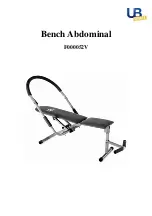
There are three basic types of weight
training methods:
1. Training for muscular
endurance and definition
2. Training for strength
3. Training for power and
muscle mass
You should select a training method
that reflects both your present fitness
level and your long term goals. You
should begin carefully and with proper
professional guidance. You can always
move from one training method to
another as you progress.
If you are beginner, you should start
slowly and carefully, gradually increasing
the frequency and intensity of your
training. Always play it safe – be realistic
about your goals and your schedule.
Realistic goals are safer and easier to
follow.
Which is the right training method
for you? First, take a look at your
present physique and determine your
objectives. Do you want a trim, toned,
well-defined body? Are you involved in
a sport where speed, strength and
power are most important? Maybe you
want bulging muscles and a terrific
V-shape torso so you look great on the
beach. Once you make a decision on
what the final results should be, you
can set up your personal program
using the proper training method to
achieve your goals.
Which training method is right for you?
DESIGNING YOUR PERSONAL ROUTINE
FOR MUSCULAR
ENDURANCE & DEFINITION
This training method incorporates
achieving and maintaining a high
cardiovascular (heart) rate and helps
burn away excess fatty tissue. It also
adds muscle definition and muscular
endurance to your entire body.
Exercises are most commonly
performed for 15 to 20 repetitions and
3 to 4 sets using a light to moderate
weight. The rest period between sets
should be about 30 seconds. These
short rest intervals will help maintain an
elevated heart rate and prevent the
muscles from cooling down.
FOR STRENGTH
This type of training is the most
popular of the three and is designed
specifically for increasing strength
throughout the muscle and the
muscle-tendon junction. This type of
training is especially important for
athletes. Normally, exercises are
performed using moderate to heavy
weight for 8 to 12 repetitions and 2 to 3
sets. The rest period between sets
should be from 60 to 90 seconds. This
allows a degree of muscle recovery
before you hit them again.
FOR POWER
AND MUSCLE MASS
This is the method most often used by
bodybuilders and is recommended
only for the intermediate and
advanced lifter. The weights used are
heavy — this shocks the muscles and
stimulates a more rapid increase in
muscle size. Usually exercises are
performed for 2 to 6 repetitions and
3 to 4 sets using very heavy weight.
The rest period between sets should
be from 3 to 4 minutes. The prolonged
rest periods allow ample time for
recovery between sets.
DETERMINE YOUR
TRAINING METHOD
FIRST:
You need to decide which of the above training methods is best
suited to accomplish your personal goals.
SECOND:
Study the exercise poster that came with your Body-Solid
machine and select one or two exercises per body part (body
parts are listed to the left of the exercise pictures). Be sure to
include exercises for all body parts. If you leave out certain
body parts your exercise routine and your body will not be
balanced. If you are trying to increase muscle mass or
increase strength to a muscle group it is alright to add extra
exercises to the area you are particularly concerned about.
THIRD:
Coordinate your body part exercise program and your
personal schedule. If you select one exercise per body part
you can normally do your entire routine in the same workout.
If you choose to do more than 12 exercises you may decide
to divide your workout routine into upper and lower body
exercises. You can split your schedule to work upper body
one day and lower body the next day. Remember to rest each
particular muscle group 48 hours before working it again.
FOURTH:
Order the exercises in your routine so you are working the
large muscle groups first and the small muscle groups last.
FIFTH:
Keep a record! Write down the exercises, number of sets,
number of reps and the amount of resistance (weight).
BEGINNER’S SAMPLE WORKOUT ROUTINE
WHEN TRAINING FOR DEFINITION
Exercise
Reps
Sets
Bench / Chest Press
15 to 20
3 or 4
Lat Pulldown
15 to 20
3 or 4
Shoulder Press
15 to 20
3 or 4
Tricep Pressdown
15 to 20
3 or 4
Bicep Curl
15 to 20
3 or 4
Leg Press/Squat
15 to 20
3 or 4
Leg Extension
15 to 20
3 or 4
Leg Curl
15 to 20
3 or 4
Calf Raise
15 to 20
3 or 4
51
16
It is important to first establish specific
and realistic goals. You should determine
your long term goal and then set a
series of short term goals that will
help you attain your long term goal.
The most common goals are:
Once you have determined your personal goals, you will need to set up a schedule
that helps you attain them. Set up a schedule that includes the number of workouts
per week, the type of workout activity, the time of day for each workout, and the actual
workout program. Don’t forget to factor in the warm up and cool down periods. You
may have to modify your current lifestyle to accommodate your new schedule. It’s very
important to include the following basic components to achieve successful results:
Muscular Endruance & Definition
Increase Power & Muscle Mass
Increase Strength
Stretching
Weight Training
Aerobic Exercise
Nutrition
If your personal goals
involve losing a
considerable amount
of body fat you will
need to focus more
on aerobic exercise
and weight training
for muscular
endurance and
definition. If your
goals involve a large
increase in muscle
size you will need to
focus on power and
muscle mass weight
training. Depending
on your goals, you
will have different
nutritional
requirements.
SETTING UP YOUR
PERSONAL PROGRAM
50
















































